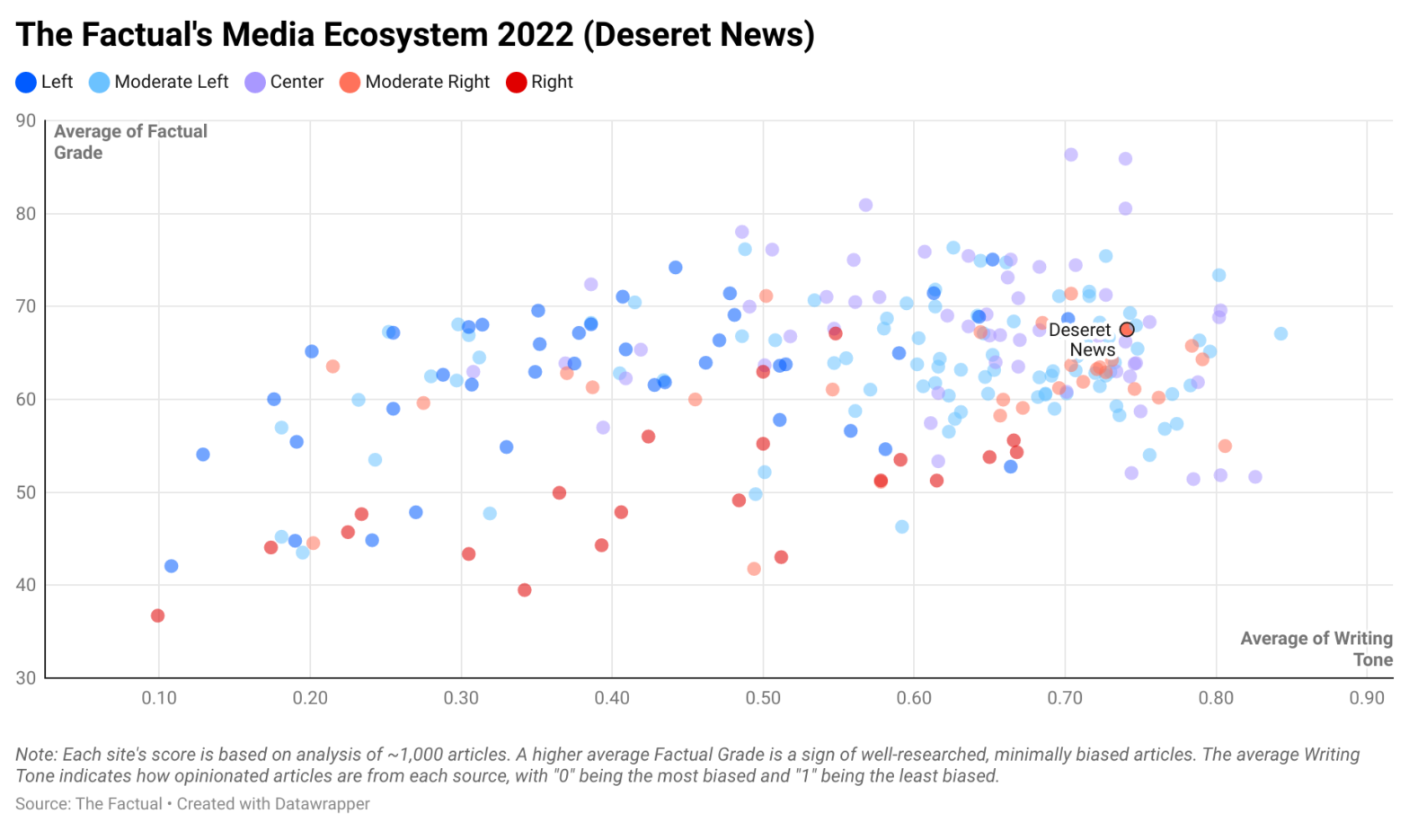Deseret News, named after a proposed state encompassing Utah, Nevada, and parts of 7 other states, published its first issue in 1850. “Deseret” comes from the word for “honeybee” in the Book of Mormon, and today the publisher is generally thought to reflect the values of its owner: the Church of Jesus Christ of Latter-day Saints. While the paper is generally understood to uphold conservative values, it has also faced accusations of “left-wing” bias. With this background, The Factual asks: how reliable is Deseret and how biased is its content?
How Does The Factual Rate News Sources?
The Factual analyzes more than 10,000 news stories every day to help readers find the most informative, least-biased articles. Our news-rating algorithm scores each article along four metrics: (1) cited sources and quotes, (2) publication history, (3) writing tone, and (4) author expertise. These scores combine in a weighted average we call a Factual Grade, which ranges from 0–100%. (See our How It Works page to learn more about our algorithm.)
For this study, we analyzed ~1,000 articles each from 240 news sources. The average Factual Grade for the entire dataset was 62.5%. Based on these averages, we can compare the performance of news sites across the media ecosystem. The entire dataset can be explored in greater detail here.
How Factual Is Deseret News?
Deseret News scored an average Factual Grade of 67.5%, placing it in the 72nd percentile of our dataset. The site’s above average scores are driven by solid performance on some of The Factual’s key metrics. For example, stories tend to be well sourced, including external links and relevant direct quotations, and are often written in an unbiased manner. However, these practices are not always in place: some articles lack adequate sourcing and others do exhibit highly opinionated language. Finally, the site receives some mixed scores for author expertise, a sign that articles may be written by authors who do not regularly write for the site or who do not have a record of covering a specific topic.
Like any news source, scores for articles from Deseret News vary widely based on these factors. For example, some scored above 90%, while others scored below 50%.
Please check your email for instructions to ensure that the newsletter arrives in your inbox tomorrow.
How Opinionated Is Deseret?
One of the metrics The Factual uses is the Writing Tone, which measures how opinionated the writing is in an article. For this metric, the algorithm looks for signs of subjective commentary (e.g., first person pronouns and unnecessary adverbs), as well as the emotional nature of selected words, and sees how prevalent they are for a given length of text. More neutral text receives higher ratings, with “0” being the most opinionated and “1” being the most neutral.
Deseret News had an average Writing Tone score of 0.74, placing it in the 87th percentile in our dataset. This suggests that articles from the site tend to use largely neutral language. This is evident in minimally biased headlines such as “6 ways the U.S. Census matters for families” and “State gives more time for comment on depleted uranium disposal.”
How Biased Is Deseret News?
The Factual classifies news sites by political bias as either Left, Moderate Left, Center, Moderate Right, or Right. This classification comes from third-party assessments from media bias organizations such as AllSides and Media Bias/Fact Check (MBFC). Based on this data, The Factual assigns Deseret News a Moderate Right bias.
AllSides classifies Deseret as “Lean Right” based on independent research and review, though they acknowledge that the publications falls very closely to a “Center” classification. Interestingly, Deseret has faced accusations of having a left-wing bias at times. Executive editor Hal Boyd responded: “Deseret News doesn’t seek to evince an overtly partisan agenda … Deseret News cares about issues that are widely considered — rightly or wrongly — conservative.” A review by AllSides in July 2021 confirmed this assessment, stating “stories of faith, family, and American history gave them a slight right lean, because these issues in modern America are largely perceived to be to the right of center.” They also noted that homepage content oscillated between centrist and right-leaning bias.
MBFC rates Deseret as “Right-Center” due to “editorial and advertising positions that favor the right.” MBFC gives the site credit for largely unbiased headlines and notes that the site’s general editorial tone varies between moderate and conservative. MBFC also gives Deseret credit for quality sourcing of information and zero failed fact checks in the last 5 years.
Please check your email for instructions to ensure that the newsletter arrives in your inbox tomorrow.
Who Owns Deseret News?
Deseret News is owned by the Church of Jesus Christ of Latter-day Saints through a series of holding companies. According to MBFC, the site generally reflects the values of the church and does not accept advertisements that violate church standards. Deseret generates revenue through advertising, subscriptions, and sponsored content.
Why Does It Matter?
News articles always have some bias because all authors have some frame of reference within which they describe a story. Political bias ratings are helpful in understanding this framing. However, it can be more beneficial to know how factual an article is based on quantifiable metrics that can be seen across the media ecosystem, such as cited evidence, author expertise, and writing tone. This is what The Factual ascertains.
Reading several, highly rated articles from across the political spectrum helps counter the bias of any news source or story. To have the day’s most factual news stories delivered to your inbox every morning, subscribe to our daily newsletter.
Article updated on September 15, 2022 to reflect new data.

